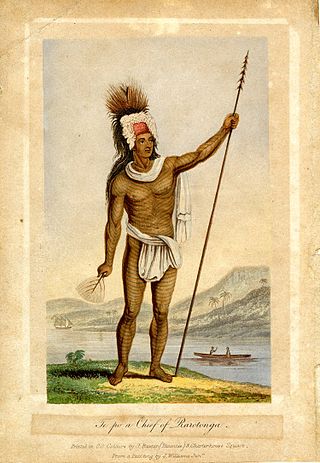
The Cook Islands are named after Captain James Cook, who visited the islands in 1773 and 1777, although Spanish navigator Alvaro de Mendaña was the first European to reach the islands in 1595. The Cook Islands became aligned to the United Kingdom in 1890, largely because of the fear of British residents that France might occupy the islands as it already had Tahiti.

Rarotonga is the largest and most populous of the Cook Islands. The island is volcanic, with an area of 67.39 km2 (26.02 sq mi), and is home to almost 75% of the country's population, with 10,898 of a total population of 15,040. The Cook Islands' Parliament buildings and international airport are on Rarotonga. Rarotonga is a very popular tourist destination with many resorts, hotels and motels. The chief town, Avarua, on the north coast, is the capital of the Cook Islands.
A paramount chief is the English-language designation for the highest-level political leader in a regional or local polity or country administered politically with a chief-based system. This term is used occasionally in anthropological and archaeological theory to refer to the rulers of multiple chiefdoms or the rulers of exceptionally powerful chiefdoms that have subordinated others. Paramount chiefs were identified by English-speakers as existing in Native American confederacies and regional chiefdoms, such as the Powhatan Confederacy and Piscataway Native Americans encountered by European colonists in the Chesapeake Bay region of North America.
A mataiapo or mata'iapo is a hereditary chiefly title in the Cook Islands. The head of a sub-tribe, subject to the ariki as far as the whole tribe is concerned and owing him traditional allegiance, but otherwise largely independent as head of his own family group and owning land in his own right.

The Kingdom of Rarotonga, named after the island of Rarotonga, was an independent kingdom established in the present-day Cook Islands in 1858. In 1888 it became a protectorate of the United Kingdom at its own request. In 1893 the name was changed to the Cook Islands Federation.
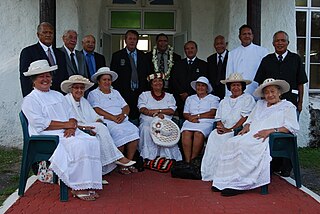
The House of Ariki is a parliamentary body in the Cook Islands. It is composed of Cook Islands high chiefs (ariki), appointed by the King's Representative. While it functions in a similar way to the House of Lords and the Senate of Canada, the country's parliament is officially unicameral. There are up to twenty-four members, representing different islands of the Cooks.
An ariki, ꞌariki, aliki, ali‘i, ari'i, Rotuma) aiki or hakaiki, akariki or ‘eiki (Tonga) is or was a member of a hereditary chiefly or noble rank in Polynesia.

Makea Takau Ariki was a sovereign of the Cook Islands. She was the ariki (queen) of the dynasty Makea Nui, one of the three chiefdoms of the tribe Te Au O Tonga on the island of Rarotonga.

Makea Pori Ariki was a sovereign of the Cook Islands. He was the ariki of the Makea Nui dynasty, one of the three chiefdoms of the Te Au O Tonga tribe on the island of Rarotonga.

Coronations in Oceania are, or were, held in the following countries:

Tinomana Mereana Ariki was a sovereign of the Cook Islands. She was the ariki of the Tinomana dynasty, a chiefdom of the Puaikura tribe on the island of Rarotonga. She was the second ariki of importance and position next to Makea Takau.
Makea Te Vaerua Ariki (b?–1857) was a sovereign of the Cook Islands. She was the ariki of the Makea Nui dynasty, one of the three chiefdoms of the Te Au O Tonga tribe on the island of Rarotonga.

Pa George Karika was a New Zealand-Cook Islands leader, clerk, soldier and farmer. Decorated for gallantry during the First World War, he was the only Cook Islander awarded the Distinguished Conduct Medal. From 1942 until his death in 1949 he was the holder of the Makea Karika Ariki title, one of the three chiefly titles of the Te Au o Tonga vaka on Rarotonga.

Ngamaru Rongotini Ariki was a sovereign of the Cook Islands. He was the ariki of the Ngamaru dynasty on the island of Atiu, one of the chiefdoms of Ngaputoru, which consisted of three adjoining islands —Atiu, Mitiaro, and Mauke. In the 1860s he married Makea Takau, a princess of Rarotonga. In 1871 Makea Takau became ariki of Rarotonga and queen regnant of the newly established Kingdom of Rarotonga, as a consequence making Ngamaru prince consort of the realm of the united Cook Islands.
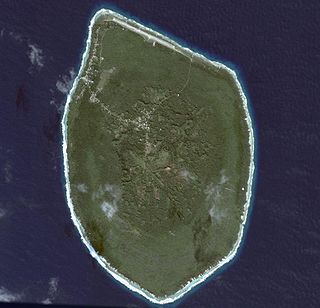
Mauke is an island of the Cook Islands archipelago, lying in the central-southern Pacific Ocean. Part of the Nga-pu-Toru, it is 277 km (172 mi) northeast of Rarotonga.
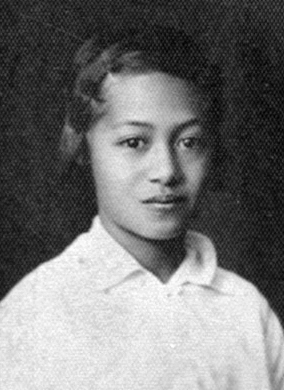
Pa Tepaeru Terito Ariki, Lady Davis was Pa Ariki, one of the two ariki titles of the Takitumu tribe on the island of Rarotonga of the Cook Islands from 1924 until 1990.

Marumaru Atua is a reconstruction of a vaka moana, a double-hulled Polynesian voyaging canoe. It was built in 2009 by the Okeanos Foundation for the Sea. In 2014, it was gifted to the Cook Islands Voyaging Society. It is used to teach polynesian navigation.
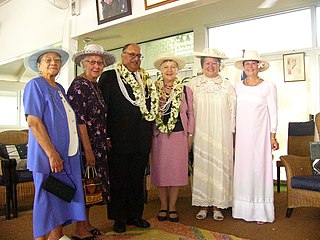
Dame Margaret Makea Karika Ariki, also known as Pauline Margaret Rakera George Karika and Pauline Margaret Rakera Taripo, was a Cook Islands ariki and holder of the Makea Karika Ariki title from 1949 to 2017. She was President of the House of Ariki from 1978 to 1980, and again from 1990 to 1992. She also served in the Legislative Assembly from 1958 to 1961.













